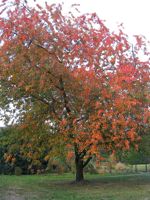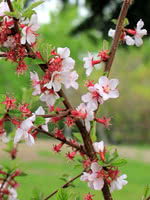Mon-Fri 9am - 5pm Mountain time
Black Cherry vs Pink Candles Nanking Cherry
Prunus serotina
Prunus tomentosa Pink Candles
NOT AVAILABLE THIS SEASON - MIGHT RETURN
NOT AVAILABLE THIS SEASON - MIGHT RETURN
Black Cherry is common in eastern North America but a rare find elsewhere. This tree is shade tolerant and is often found in old fields, forest openings, and along fencerows.
The fruit is edible and is commonly used to flavor rum and brandy. It is also edible and often eaten fresh or used in wine or jelly. Black Cherry trees typically begin producing fruit when they are 10 years of age.
Black Cherry wood is a rich reddish-brown color and is strong, making it valued in cabinetry and woodworking. It is often used in reclamation as well.
The leaves can poison livestock as they contain cyanide derivatives and precursors. However, many have noted that deer still seem to browse their trees with impunity and birds and other animals eat the fruit when available.
The Pink Candles Nanking Cherry is a small deciduous cultivar of the Nanking Cherry with attractive pink flowers that then form edible fruit. The flowers emerge close to the branches resembling a pink candle, giving this cultivar its name. The berries are scarlet in colour with a sweet and slightly tart flavor. It fruits mid to late July, and the fruit size and flavor can vary greatly.
The Pink Candles Nanking Cherry is a good choice for use in hedges. It is closely related to plum trees so it can pollinate certain plum species.
.
Black Cherry Quick Facts
Pink Candles Nanking Cherry Quick Facts
Toxicity: bark and wilted leaves toxic to livestock

